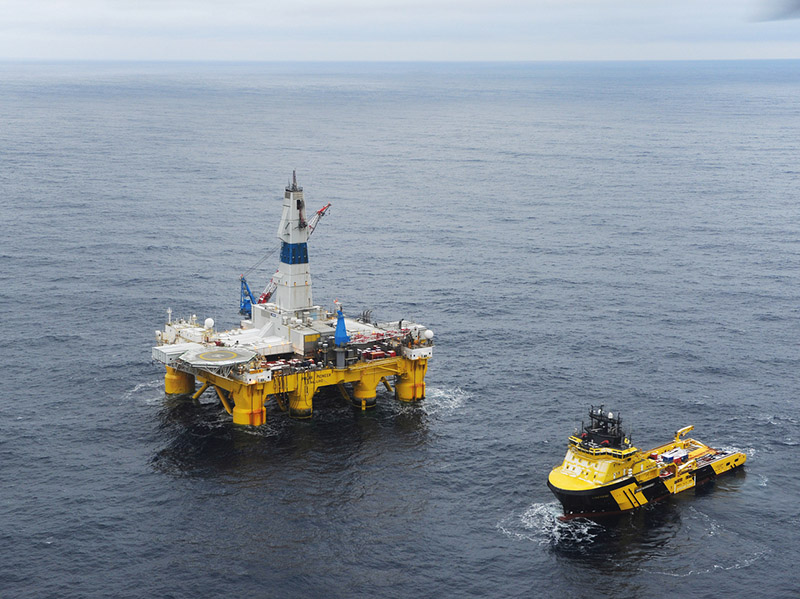(Bloomberg) — With the oil industry barely recovering from its most brutal slump in decades, you might expect the Arctic Ocean to be the last place explorers would hunt for new discoveries.
The Barents Sea off Norway’s northern tip is different.
Norwegian authorities expect companies including Lundin Petroleum AB and OMV AG to drill a record 15 wells in the Barents this year. Statoil ASA’s Songa Enabler, a floating drilling machine the size of two football fields, is in the vanguard of those efforts as it embarks on a five-well exploration campaign.
The Barents enjoys a number of advantages over the U.S. Arctic, where President Donald Trump is pushing to expand drilling. Thanks to the Gulf Stream, it’s largely ice-free, unlike other areas such as Alaska and Greenland, which have been deserted by oil companies like Royal Dutch Shell Plc. The relatively shallow waters off Norway mean drilling is less costly, while the potential prize is huge: the Enabler’s fourth well will be Korpfjell, probably the largest prospect to be tested offshore Norway since the 1990s.
“It’s the biggest remaining structure that we know of on the Norwegian shelf,” Tim Dodson, head of exploration a state-controlled Statoil, said aboard the rig last week. “It’s important for us, and for northern Norway — and the entire country, actually.”
Norway is betting the under-explored Barents could boost its oil industry, after crude production fell by half since 2000. There could be more than 17 billion barrels of oil and gas yet to find here, or almost 65% of Norway’s undiscovered resources, according to estimates from the Norwegian Petroleum Directorate.
In Hammerfest, the regional oil hub that bills itself as “the northernmost town in the world,” the industry downturn since 2014 that prompted tens of thousands of job cuts along Norway’s North Sea coast has gone largely unnoticed.
Encircled by snow-clad hills on a fjord south of the town center, Polarbase AS serves ships supplying the Songa Enabler and other rigs. When oil exploration in the Barents was halted for six years during the 1990s, Polarbase survived by selling snow scooters and farming salmon. This time is very different.
Exploration is booming and “we’re now focused on oil and gas,” said Ketil Holmgren, manager of Polarbase.
Statoil, Lundin and OMV have already made discoveries totaling more than a billion barrels in the Barents Sea since 2010, and Eni SpA last year started producing oil from Goliat, the area’s first platform. Statoil plans to make a final investment decision on the Johan Castberg project this year after reducing costs by more than 50%.
Even with the Gulf Stream, which pumps warm water north across the Atlantic Ocean and cold water south, the Enabler rig is “winterized” and can withstand temperatures down to -25 degrees Celsius — complete with a heated emergency-exit path on deck. But apart from a few scattered snowflakes in the late-April air, there’s little to suggest you’re deep inside the Arctic Circle.
Korpfjell is high-risk — Dodson sees a one in six chance of making a find there — but its multi-billion barrel potential could also prove high-return. With a higher probability for Statoil’s other targets, he expects to make at least one discovery.
With the basin bucking the global downturn in offshore exploration, the government has proposed a record number of Barents blocks in its next licensing round.
Despite industry optimism, Arctic drilling remains controversial in Norway, a country of 5.3 million people that became one of the world’s richest after striking oil in the North Sea in the late 1960s.
Environmental groups such as Greenpeace and WWF say drilling rigs are going too close to the edge of the polar ice sheet — a fragile ecosystem that sustains species from plankton to mammals — posing catastrophic threats in case of a spill. A debate is also raging over whether oil and gas in the remote Barents can be profitable amid efforts to fight climate change that could cause demand for fossil fuels to plummet.
If Arctic projects don’t pay off, that could mean billions of dollars of lost revenue for the Norwegian government, which offers generous refunds and deductions for exploration and investment in a trade-off for imposing a high tax rate on oil production.
“There’s a very high probability that these investments will be stranded assets,” said Jens Ulltveit-Moe, a Norwegian investor who made part of his $400 million fortune in oil-related ventures, before selling them more than a decade ago.
Statoil and Norway’s Petroleum and Energy Minister Terje Soviknes don’t agree.
“With a break-even price of $35 a barrel, we’re competitive and then some,” he said in an interview on board the Enabler, referring to Statoil’s Castberg project. “That makes a lot of the stranded-assets debate disappear.”
Statoil’s Barents Sea wells are among the cheapest in its global exploration portfolio this year, at $25 million apiece at most, Dodson said.
“It’s a bit of a myth, to be quite honest, that things are so much more costly up here,” he said.
That’s good news for Hammerfest, where the oil industry has created 1,200 jobs since Statoil decided 15 years ago to build a liquefied natural gas plant to process production from the Snovhit deposit, the Barents Sea’s first field.
The town used to be a “run-down” place from which you moved away if you wanted to get ahead, said Polarbase’s Holmgren, a 55-year-old native of Hammerfest. Now, “young people who leave have plans to come back.”
Bloomberg News by Mikael Holter





